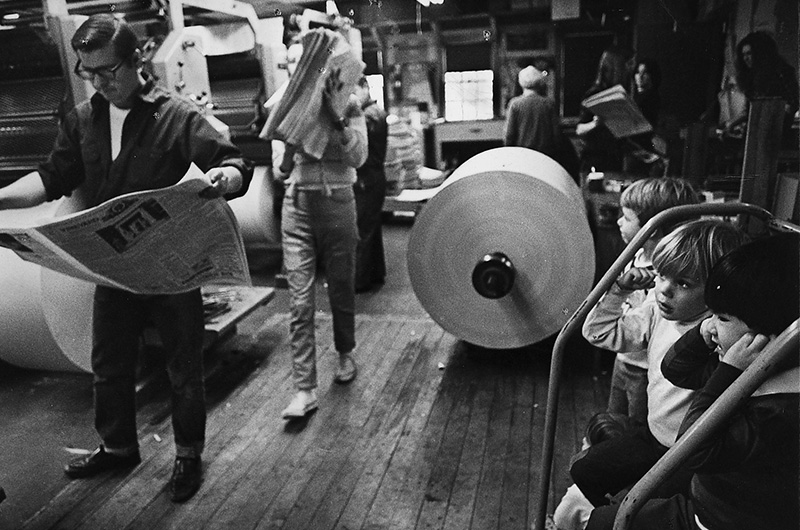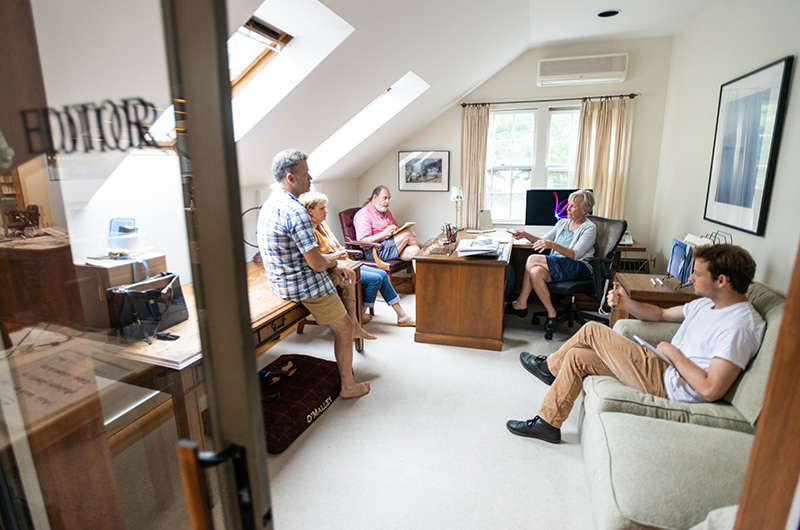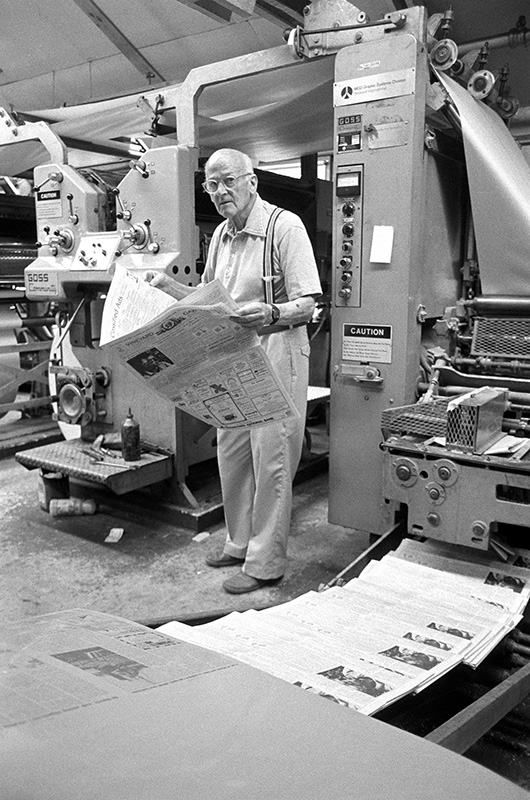If you placed a single edition of every Vineyard Gazette on top of each other, going back to its first publication date of May 14, 1846, the huge tower would stretch upwards of 100 feet.
To save space, Anna Barber, curator of a new exhibit about the Gazette opening Saturday at the Martha’s Vineyard Museum, created a sample tower just 12 feet high. But the visual helps tell the story in a tangible way of a newspaper that has spanned centuries, never missing a weekly print run.
Tomorrow’s History: 175 Years of the Vineyard Gazette runs through Oct. 24. It tells the continuing story of a community newspaper that began its life under publisher Edgar Marchant reprinting stories about other places culled from newspapers around the country. Eventually, the newspaper turned its focus to Martha’s Vineyard itself, covering its people from birth to death, its issues from controversial to heartwarming, and its culture from a relatively unknown idyll off the coast of Massachusetts to a destination known world-wide.
For Ms. Barber, the exhibit proved to be a particular professional challenge.
“We’ve never done an exhibit about an organization or business that is still going on,” she said this week, while putting the finishing touches on the show. “You know, how do you do an exhibit about a business that tells stories and has 175 years of stories?”
In fact Ms. Barber has used many of the stories and relied on the Gazette for her own research in curating exhibits for the museum.
“I don’t think there’s a single exhibit that I’ve done that I haven’t used the Gazette as a resource,” she said. “Because that is one of the first places that we go to check facts, check figures, get details, to figure out what was going on at the time.”
Over the past year, Ms. Barber met with Gazette publisher Jane Seagrave and other staff members to generate ideas and begin laying out the themes she wanted the exhibit to cover.
“We all agreed the show should make clear that the Gazette is still a living, breathing, changing enterprise and not something preserved in amber,” said Ms Seagrave. “The challenge was how to portray that in a visual way.”
Working closely with Hilary Wallcox, the Gazette librarian, Ms. Barber’s first priority was to find three-dimensional objects to tell a story that is largely about the written word.
The resulting exhibit is a marrying of past and present, which is immediately evident in a triptych of an old Underwood typewriter from the 1930s, an early word processor from the 1980s, and an iPad displaying the Gazette’s website, vineyardgazette.com.
“The iPad will be refreshed daily to show that day’s stories that are being published,” Ms. Barber said.
The exhibit highlights the breadth of newspaper’s coverage, the growing importance of photography and the changing concerns of the community reflected in news stories and letters to the editor.
The evolution of the printing process is also featured with the inclusion of a small hand-held press dating to the 1800s and a ladle that was used to pour hot lead.
The ladle is one of Bow Van Riper’s favorite parts of the exhibit. Mr. Van Riper is the museum’s historian and worked with Ms. Barber and Ms. Wallcox on the exhibit.
“It puts you in the middle of a world that no longer exists,” he said, referring to the painstaking physical process once required to produce even a single sheet of newsprint.
As a historian who spent much of his professional career as an academic, Mr. Van Riper was particularly concerned with representing the sheer scope of time the Gazette has been publishing.
“An over-arching theme in the whole exhibit is that this paper has seen so much change,” he said. “It was first published in the horse and buggy height of the whaling era, when the Edgartown streets were paved with scallop shells and there weren’t even gas lamps to light your way home from a prayer meeting at the Methodist Church. And here it is still now in the 21st century, in the age of constantly updated everything. One of the things that I know all too well from all my years teaching history is that it’s hard to convey change over time beyond the human lifespan. But this exhibit does that.”
Another tangible expression of this is an exact reproduction of legendary Gazette owner and country editor Henry Beetle Hough’s desk, painstakingly recreated from old photographs. The desk holds pride of place in one room, so completely covered in papers, books, notes and various odds and ends it is a wonder Mr. Hough could even work at it. A photograph next to the desk shows that he couldn’t — he sits swiveled away from the desk writing on a pad balanced on his knee.
For Ms. Barber, the Hough desk is another example of what she hopes visitors to the exhibit will take home with them — an appreciation of the work that goes into each edition of the paper.
“The organized chaos on the phone, the research, the files, the phone calls — it’s the magical heart and hard work we all take for granted,” she said. “Hopefully, people will leave the exhibit feeling more aware that it isn’t just today’s news they are holding, it’s a piece of history.”
Visitors to the exhibit will be able to take a bit of that history home with them in the form of each week’s print edition. They will also be able to leave a bit of history behind by recording their thoughts and memories of the paper as part of an oral history.
Tomorrow’s History: 175 Years of the Vineyard Gazette, opens Saturday and runs through Oct. 24 in the Grain Gallery at the museum. For information, visit mvmuseum.org.










Comments (4)
Comments
Comment policy »